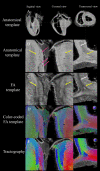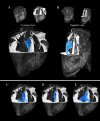A groupwise registration and tractography framework for cardiac myofiber architecture description by diffusion MRI: An application to the ventricular junctions
- PMID: 35849598
- PMCID: PMC9292118
- DOI: 10.1371/journal.pone.0271279
A groupwise registration and tractography framework for cardiac myofiber architecture description by diffusion MRI: An application to the ventricular junctions
Abstract
Background: Knowledge of the normal myocardial-myocyte orientation could theoretically allow the definition of relevant quantitative biomarkers in clinical routine to diagnose heart pathologies. A whole heart diffusion tensor template representative of the global myofiber organization over species is therefore crucial for comparisons across populations. In this study, we developed a groupwise registration and tractography framework to resolve the global myofiber arrangement of large mammalian sheep hearts. To demonstrate the potential application of the proposed method, a novel description of sub-regions in the intraventricular septum is presented.
Methods: Three explanted sheep (ovine) hearts (size ~12×8×6 cm3, heart weight ~ 150 g) were perfused with contrast agent and fixative and imaged in a 9.4T magnet. A group-wise registration of high-resolution anatomical and diffusion-weighted images were performed to generate anatomical and diffusion tensor templates. Diffusion tensor metrics (eigenvalues, eigenvectors, fractional anisotropy …) were computed to provide a quantitative and spatially-resolved analysis of cardiac microstructure. Then tractography was performed using deterministic and probabilistic algorithms and used for different purposes: i) Visualization of myofiber architecture, ii) Segmentation of sub-area depicting the same fiber organization, iii) Seeding and Tract Editing. Finally, dissection was performed to confirm the existence of macroscopic structures identified in the diffusion tensor template.
Results: The template creation takes advantage of high-resolution anatomical and diffusion-weighted images obtained at an isotropic resolution of 150 μm and 600 μm respectively, covering ventricles and atria and providing information on the normal myocardial architecture. The diffusion metric distributions from the template were found close to the one of the individual samples validating the registration procedure. Small new sub-regions exhibiting spatially sharp variations in fiber orientation close to the junctions of the septum and ventricles were identified. Each substructure was defined and represented using streamlines. The existence of a fiber-bundles in the posterior junction was validated by anatomical dissection. A complex structural organization of the anterior junction in comparison to the posterior junction was evidenced by the high-resolution acquisition.
Conclusions: A new framework combining cardiac template generation and tractography was applied on the whole sheep heart. The framework can be used for anatomical investigation, characterization of microstructure and visualization of myofiber orientation across samples. Finally, a novel description of the ventricular junction in large mammalian sheep hearts was proposed.
Conflict of interest statement
The authors have declared that no competing interests exist.
Figures








Similar articles
-
Cardiac structure discontinuities revealed by ex-vivo microstructural characterization. A focus on the basal inferoseptal left ventricle region.J Cardiovasc Magn Reson. 2023 Dec 14;25(1):78. doi: 10.1186/s12968-023-00989-y. J Cardiovasc Magn Reson. 2023. PMID: 38093273 Free PMC article.
-
Helical structure of the cardiac ventricular anatomy assessed by diffusion tensor magnetic resonance imaging with multiresolution tractography.Rev Esp Cardiol (Engl Ed). 2013 Oct;66(10):782-90. doi: 10.1016/j.rec.2013.04.021. Epub 2013 Jul 25. Rev Esp Cardiol (Engl Ed). 2013. PMID: 24773858
-
Comparison of diffusion tensor imaging by cardiovascular magnetic resonance and gadolinium enhanced 3D image intensity approaches to investigation of structural anisotropy in explanted rat hearts.J Cardiovasc Magn Reson. 2015 Apr 29;17(1):31. doi: 10.1186/s12968-015-0129-x. J Cardiovasc Magn Reson. 2015. PMID: 25926126 Free PMC article.
-
Measuring and mapping cardiac fiber and laminar architecture using diffusion tensor MR imaging.Ann N Y Acad Sci. 2005 Jun;1047:296-307. doi: 10.1196/annals.1341.026. Ann N Y Acad Sci. 2005. PMID: 16093505 Review.
-
Myocardial mesostructure and mesofunction.Am J Physiol Heart Circ Physiol. 2022 Aug 1;323(2):H257-H275. doi: 10.1152/ajpheart.00059.2022. Epub 2022 Jun 3. Am J Physiol Heart Circ Physiol. 2022. PMID: 35657613 Free PMC article. Review.
Cited by
-
Cardiac structure discontinuities revealed by ex-vivo microstructural characterization. A focus on the basal inferoseptal left ventricle region.J Cardiovasc Magn Reson. 2023 Dec 14;25(1):78. doi: 10.1186/s12968-023-00989-y. J Cardiovasc Magn Reson. 2023. PMID: 38093273 Free PMC article.
-
Considerations and recommendations from the ISMRM Diffusion Study Group for preclinical diffusion MRI: Part 3-Ex vivo imaging: Data processing, comparisons with microscopy, and tractography.Magn Reson Med. 2025 Jun;93(6):2561-2582. doi: 10.1002/mrm.30424. Epub 2025 Feb 26. Magn Reson Med. 2025. PMID: 40008460 Free PMC article. Review.
References
-
- Allessie MA, de Groot NM, Houben RP, Schotten U, Boersma E, Smeets JL, et al.. Electropathological substrate of long-standing persistent atrial fibrillation in patients with structural heart disease: longitudinal dissociation. Circ Arrhythm Electrophysiol. 2010;3(6):606–15. doi: 10.1161/CIRCEP.109.910125 . - DOI - PubMed
Publication types
MeSH terms
LinkOut - more resources
Full Text Sources

